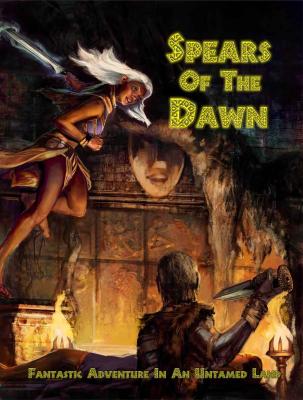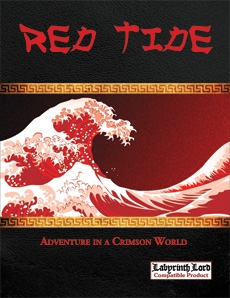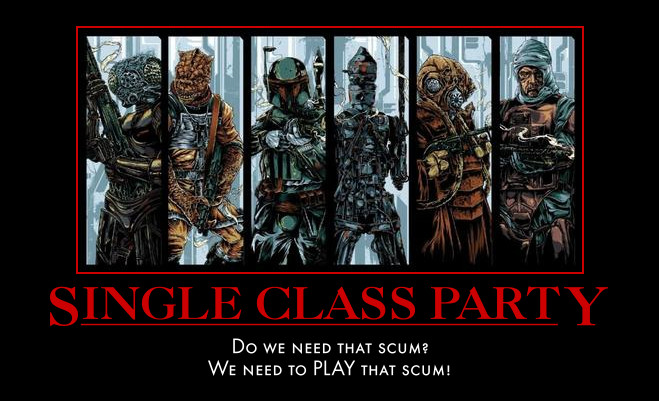Spears of the Dawn is another small sandbox setting by Kevin Crawford, who also did the excelent Red Tide setting. While Red Tide uses a great number of elements from Chinese and Japanese culture, Spears of the Dawn is strongly based on various cultures of West Aftica. The book consists of roughly three parts: A complete roleplaying game, the Spears of the Dawn campaign setting, and advice on running sandbox games. These are not clearly divided into three section though, and it’s probably best to read the whole thing even if one only intends to use certain elements of it. It’s made clear in the introduction that this book is meant to be mined for ideas and its elements disassembled and repurposed as any GM sees fit. Like Red Tide, it is more of an example of how a great sandbox setting can look like and how you make one.
 The Setting
The Setting
The setting presented in Spears of the Dawn are the Three Lands. Two centuries ago the empire of the Nyala was close to conquering all of the other five kingdoms of the Three Lands and when the king of Deshur was forced to retreat with his remaining army into the desert he discovered the means to make himself and his followers into Eternals. The Eternals are powerful undead who neither age, nor need to eat or drink, but maintain their youth and heal any wounds through the eating of human flesh. For over a hundred years the Eternal invaded the lands of the Five Kingdoms and causing the empire to fall apart. Eventually the emperor of Nyala accepted that the other four kingdoms were no longer under his control and instead created an alliance of equals to destroy the Eternals and put an end to the terror of the Sixth Kingdom. The Five Kingdoms where victorious and the Sixth Kingdom no more, but they were unable to destroy all of the Eternals as some of them escaped into the wilderness and continue to exist in hiding to this day. In the fourty years that have passed since then, the fate of the new Five Kingdoms has remained uncertain. There is peace now, but the former subjects of the Nyala still have resentments against their former masters and there are still many bands of raiders and new settlements created by refugees from the war are not always getting along well with their neighbours. The last emperor had anticipated that some of the Eternals might escape from the armies of the Five Kingdoms and created a group of warriors, shamans, and sorcerers called the Spears of the Dawn, who were given the duty to hunt down the remaining Eternals and destroy any lingering trace of their evil. With the empire being no more and Nyala being only one kingdom among others, the Spears of the Dawn lack any real leadership or organization. However, with the threat of the Eternal and other evils still around, there are always more people who take up arms and wander the Five Kingdoms to destroy them. With many elders still remembering the terror of the Eternals well, these warriors against evil are highly respected and stand somewhat outside of the normal tribal politics and regular social classes.
It’s a nice compact setting, though I am feeling a bit ambivalent about the post-colonial character of the Five Kingdoms. I would consider my knowledge of African politics and social issues only slightly above average and tribal affiliations and great class inqualities appear to be indeed an important factor in regional and social conflicts. However, to a large degree these conflicts are the result of the British and French colonial empires and their sudden disappearance that left many regions in administrative chaos. Using contemporary Real-World conflicts as a template for a fictional medieval African-inspired setting seems a bit problematic to me. It’s not exactly a respectful treatment of a cultural region and its people to focus on one of their darkest periods which was primarily caused by outside forces. However, Spears of the Dawn doesn’t reduce the African theme of the setting to only that element and there is a lot more than that. And it isn’t like precolonial Africa was all happy paradise. There has always been as much tribal war and violence, as well as slavery and exploitation of lower social classes in Africa as in all the other continents of the world. When empires fell apart in Europe, the result was always just as ugly. So I am inclined to give this setting a pass in this regard. While I probably would have stayed clear of that aspect myself, the way it is treated here seems pretty well balanced and I think you have to actually know what to look for to notice any real world similarities at all. Continue reading “RPG Review: Spears of the Dawn”


